|
FAQs on Anemone Identification
40
Related Articles: Anemones,
Bubble
Tip Anemones, LTAs, Cnidarians, Coldwater Anemones, Colored/Dyed Anemones,
Related FAQs: Anemone ID 1, Anemone ID 2, Anemone ID 3, Anemone ID
4, Anemone
ID 5, Anemone ID
6,
Anemone ID 7,
Anemone ID 8,
Anemone ID 9, Anemone ID 10,
Anemone ID
11,
Anemone ID 12, Anemone ID 13, Anemone ID 14, Anemone ID 15,
Anemone ID
16, Anemone ID 17, Anemone ID 18, Anemone ID 19,
Anemone ID 20,
Anemone ID 21, Anemone ID 22, Anemone ID 23, Anemone ID 24, Anemone ID 25, Anemone ID 26, Anemone ID 27, Anemone ID 28, Anemone ID 29, Anemone
ID 30, Anemone ID 31,
Anemone ID 32,
Anemone ID 33,
Anemone ID 34, Anemone ID 35,
Anemone ID 36, Anemone ID 37, Anemone ID 38, Anemone ID 39, Anemone ID 41,
Anemone ID 42,
Anemone ID 43, Anemone ID 44,
Anemone ID 45,
&
Cnidarian
Identification,
|
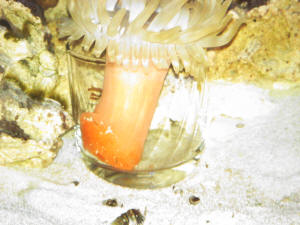
|
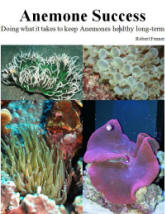 |
New Print and
eBook on Amazon:
Anemone Success
Doing what it takes to keep Anemones healthy long-term
by Robert (Bob) Fenner
|
|
anemone
identification
6/16/11
I have two critters I need help identifying; see attached
pictures.
<I see them>
The first image is labeled "Manjo.jpg" as that is the
closest thing I can find to a match.
<Is likely Anemonia>
I have had a couple of these on the top of a Zoanthid rock.
Picture is a night shot with tentacles extended. In daytime,
shrinks down with elongated pear shaped tentacles. The nearby
zoos expand and contact it. These things are just under 1cm wide
including extended tentacles. Don't seem to grow at all,
though have divided twice over 7 months. Dark spot at oral
opening. Have never seen it feed on anything.
I have tried to kill with Kalk injection a few times, but it
returns.
Unlike reputation of manjo for stinging, these live comfortably
next to the zoos which show now signs of distress.
Second image is labeled "Hydroid.jpg", again my best
guess. This one also does not appear to sting the zoos. It is
about 1.5cm across, white bubble tips, transparent tentacles,
does not really have an oral disk, pinched oral opening. There
are two of these things in the tank but on different rocks.
<No hard skeleton? Likely a Pseudocorynactis sp.>
Are these ID's correct? What should I be doing?
<Read on WWM re>
Tank specs: 185 gal, Stocked with SPS, LPS, Zoanthids, 1 BTA, 1
ocellaris, 5 tangs, 5 peppermint shrimp, various snails and
hermits. Tank running 9 months now. Tank skimmed, no GAC. Average
daily pH 8.25, Temp 77 F, PO4 ~ 0.03 ppm, NO3 ~ 0.5 ppm, NO2, NH4
not measurable, Alk 9 dKH.
Thanks as always for a great site,
Edward
<Welcome the same. Bob Fenner>
|
|
 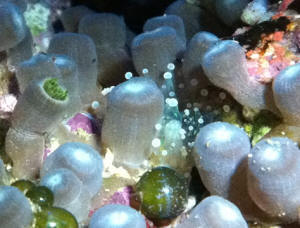
|
|
Anemone ID (Corallimorpharian) –
05/30/11
Hi,
<<Hello>>
I’ve had this unknown anemone in my tank for a few months now
and I’m wondering what it is also is it a pest?
<<The pic is a bit dark but this looks like a Corallimorph
to me, more specifically, a species of Ricordea. Some might
consider it/them a pest (are very strong/aggressive, and can be
invasive under the right conditions), though most folks seem to
relish them as quite colorful additions. Do a web search on the
genus name and see what you think>>
Thanks, Jase
<<Happy to share… EricR>>
|
|
%20amen%20shroom%20id.jpg)
|
|
Manjano <Hey Deucy!> Pest
possibly? 5/18/11
Could you please help me to identify the unknown in the
attached
picture?
<Mmm, don't know what this is. Appears to be an
Actinarian, but don't know what family...>
I have searched your web site and think it could possibly be a
Manjano variety but am not sure, I understand that if it is then
I need to remove it from my tank. My tank has been running for 2
years
now and not really had much added to it for several months, this
'thing' in the picture has appeared from nowhere and
seems to be buried in the sand (if it needs removing this could
be a good thing as trying to eradicate Aiptasia from rocks is
hard work!)
<I'd leave it be, enjoy it... doesn't look like
it's anywhere that will harm other sedentary
livestock>
I look forward to hearing from you in due course and thank you in
advance for any information you can pass to me.
Kind regards
Kaz
<You can peruse WWM re Anemone ID (again), but... Bob
Fenner>
|
|
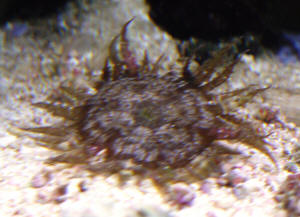
|
Re: Manjano Pest
possibly? 5/18/11
Many thanks for your assistance, I was also wondering if there is a
possibility it could be one of the Aiptasia family, but will leave
alone for now and see what happens
<Again, I don't really know what this chappy might be... but
as it is small, single... apparently not causing issues, I'd
keep it! Cheers, BobF> |
|
Anemone/Sebae/
>not< Condylactis Systems/Health 4/24/2011
Hello,
<Hello Chris>
thanks in advance for answering my questions.
<You're welcome.>
I recently purchased two anemones from a pet store franchise,
which was probably my first mistake.
<Maybe.>
I bought a Condy anemone and a white sebae anemone. The pet store
put both of the anemones in the same bag for
transport home, which I found to be strange to begin
with.
<Did you not realize this was not good?>
They were both attached to the glass when I got them and the
sebae was a tannish color which I have read too be a sign of good
health.
<Not necessarily.>
The car ride home was about an hour in distance.
<Oh boy, stinging each other for an hour.>
Since, then they have both been drip acclimated and placed in my
tank. The Condy has attached to a piece of live rock where it
first landed in the tank and the white sebae has seemed pretty
much lifeless floating with the current until it hits a piece of
live rock and semi attaches. They have been in the tank for about
24 hours and since then the Condy has stayed attached to the live
rock in which it landed on, but has been about 80% retracted
basically the entire time.
<Not unusual.>
The Condy has been retracting more when anything gets around it
so I know it is still alive. The sebae seemed to stay attached at
the spot where it landed until this morning where I noticed it
pretty much rolling over due to the current. I am more concerned
about the health of the sebae because it seems to be doing the
worse of the two.
<Not surprising.>
I was thinking that they might have damaged or killed one another
on the way home from the pet store and was hoping you could give
me some insight to this.
<Kind of late now, isn't it. Should have researched these
animals and their needs before you even bought them.>
I was also hoping you may let me know if there are any
improvements I can make to my aquarium setup. I have a 40 gallon
breeder tank
<Too small for the Sebae Anemone.>
with 55 pounds of premium Fiji live rock, 30 pounds of live
aggregate, and run 2-36 inch t5 bulbs, which consist of a10,000k
bulb along with a t5 actinic 460 bulb, for my lighting.
<Not enough light for these animals, soon to die.>
I run a canister filter that is regulated for up to 100 gallons
and also have a 1050 gph powerhead. My protein skimmer is rated
for up to 80 gallons and seems to do a good job except for the
fact that I have to adjust the air water mixture about 2 to 3
times a week for it to start producing again. My inhabitants
consist of 14 margarita snails, 4 hermit crabs, a coral banded
shrimp, 2 juvenile clown fish, a coral beauty dwarf angel, and a
yellow tang.(and the two unhealthy looking anemones)
<Tank too small for the tang as well and in this small space
your fish risk a good chance of being stung.>
My parameters are continuously at zero with the exception of my
nitrates which stay at about 10 ppm. I apologize for the long
winded explanation and I appreciate the service that you provide
and look forward to your advice and hopefully letting you know
that they both have pulled through and are flourishing.
<I suggest to see if you can return these animals, is not
going to work out in your system. Do read here.
http://www.wetwebmedia.com/marine/inverts/cnidaria/anthozoa/heteraccrispa.htm
http://www.wetwebmedia.com/condyanemones.htm
James (Salty Dog) Lake Huron Coast>
Chris Jenkins MS gulf coast
|
|
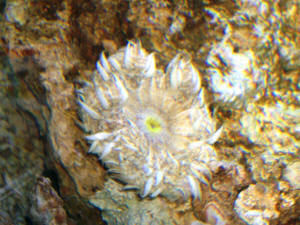 Not Condylactis sp... Trouble altogether...
RMF Not Condylactis sp... Trouble altogether...
RMF
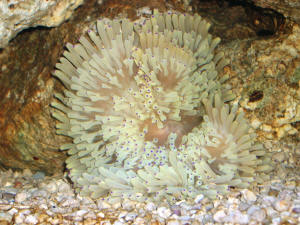 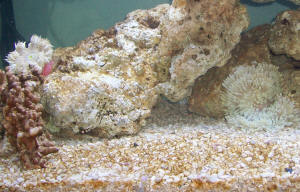
|
|
Re Anemone/Sebae/ >not< Condylactis
Systems/Health 4/24/2011
My oversight on the Condy Bob. Meant to state this in the query
but after I got into the message, I forgot, and clicky, sendy.
I've actually had one of these anemones in the past.
James
<Do you know what this species is? BobF>
Re Anemone/Sebae/ >not< Condylactis
Systems/Health 4/25/11
I do not
know the name of this species but I believe it is a member of the
Phymanthidae family but I'm not positive.
Cheers,
J
<Thank you for this. B>
|
|
anemone ID
4/10/11
Hello, and thanks for the wonderful site.
<Ave and thank you>
I received this anemone from a fellow hobbyist on a trade and
having been trying to ID it since. I've looked through
countless faqs and pictures, but I can't settle on positive
ID. Every time I think I have it, I do some research and start
second guessing myself. Please check the picture and let me know
what you think.
<Mmm, Heteractis malu. See here:
http://www.wetwebmedia.com/marine/inverts/cnidaria/anthozoa/anemones.htm
As you can see, it has attached itself to a drinking glass. I sat
it in there while moving some things around, and it quickly
attached itself. It is nice for getting pictures of the
foot/column though! Sorry for the poor quality of the picture,
it's from my phone.
Thanks,
Tom
<From the shape, smoothness of the pedicle, colour mostly.
Cheers! Bob Fenner>
|
|

|
|
Re: anemone
ID 4/10/11
Thanks for quick response. Malu was my leading candidate, so
you've reassured me greatly. What would you suggest I do
about the glass?
<Mmm... I guess I'd leave it for now... this animal will
likely move elsewhere in time>
Before it attached there, it mostly just floundered around one
area of the tank. I had tried digging a hole so it could attach
to the tank bottom, but sand eventually got under the foot and it
let loose again.
I don't won't to damage it trying to remove it from the
glass, but it's too tall to bury it and leave it.
<Do read on WWM, books, elsewhere on the Net re this species.
BobF>
Re: anemone ID 4/10/11
Thanks again. I'll leave it as long as it's happy in
there.
<Ah good. BobF>
|
|
|

